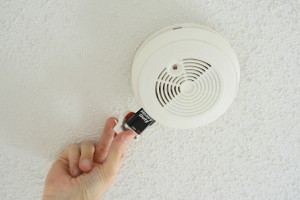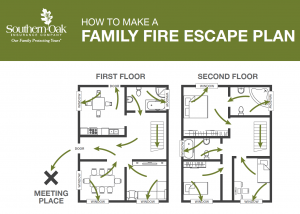Fire education isn’t just for kids. Adults, teenagers and especially the elderly are at risk in the event of a fire and every second counts when it comes to getting out safely. Every member of your family needs to be educated on how to prevent fires at home and how to get out in case a fire does occur. You should also share this information with your neighbors and local community. The National Fire Prevention Association has developed their Look, Listen, Learn campaign for Fire Prevention Week to help everyone understand the role they play in fire prevention.
LOOK
They say a watched pot will never boil, but an unattended frying pan is a sure way to start a kitchen fire. It should come as no surprise that leaving cooking unattended is the leading cause of home fires, causing nearly half (47%) of all home fires each year, on average. It’s important to remove clutter from around cooking surfaces and appliances. Keep anything that can burn away from the stovetop, such as towels, oven mitts and food packaging. Also avoid cooking if you’re sleepy or maybe had a little too much to drink.
The second-leading cause of U.S. home fires comes from heating your home. On average, 15% of reported home fires each year comes from heating equipment. Failing to clean your equipment by allowing dust to collect on heating vents or not sweeping your fireplace chimney are leading causes of heating fires. Keep anything that can burn at least three feet away from heating equipment and turn off space heaters when you leave a room or fall asleep.
Electrical or lighting fires are often overlooked by homeowners, but are involved in the ignition of 34,000 U.S. home fires, on average per year. These fires involve equipment such as wiring, lighting, cords and plugs. Make sure to have all electrical work done by qualified electricians. Major appliances should be plugged directly into wall receptacles and not power strips. Only use one heat producing appliance (such as coffee makers and toasters) per outlet at a time.
Fires from candle and smoking materials are both major causes of home fires. More than half of all candle fires start when things that can burn are too close to the candle. Avoid using candles in bedrooms or areas where people may fall asleep and keep candles at least one foot away from anything that can burn. Cigarettes, pipes and cigars should be smoked outside to avoid catching materials in the home on fire. Keep smoking materials, lighters and matches up high and if possible, in a locked cabinet away from curious children. Use e-cigarettes with caution and never leave them charging for a longer period of time unattended.
LISTEN
The NFPA reminds us that smoke alarms are the FIRST line of defense in a fire by alerting everyone early enough to get out safely. Smoke alarms should be maintained regularly. Make sure you have equipped your home properly. Install a smoke alarm on every level of your home, in all bedrooms or near sleeping areas. Test your smoke alarms monthly to make sure they are working, replace batteries every 6 months and replace any alarms more than 10 years old.
LEARN
When a fire does occur, you may only have a few minutes to get everyone out safely. It’s important for you to learn two ways out of every room and teach children how to escape safely. Make sure your family is aware of how to escape a fire from any floor of your home and designate an easy place outside in front of your home (a tree, mailbox, etc.) where everyone agrees to meet and check in safely. We recommend developing an escape plan with your family by using our Fire Escape Plan here and practicing it twice a year









